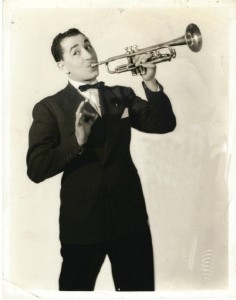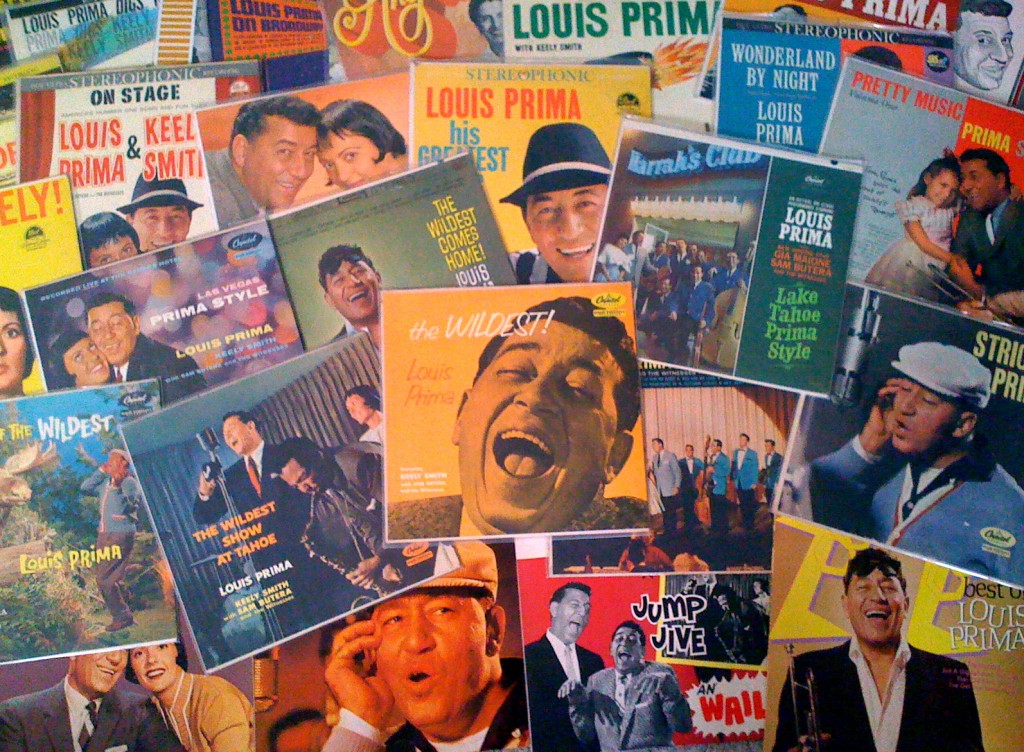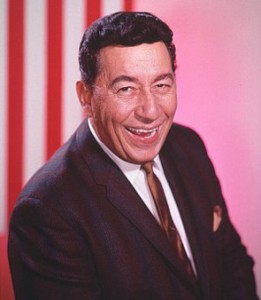To one generation of fans, he was the “Wildest” show in Vegas and Tahoe.
To another, he was the voice of “King Louie the Most.”
To Sam Butera and the Witnesses, he was known simply as “The Chief.”
 Louis Prima was born on December 7, 1911—thirty years before the date began to “live in infamy”—in the Little Palermo section of New Orleans’ French Quarter. It’s fitting that he came into the world surrounded by a tossed salad of nationalities (his neighborhood was home to Italians, Jews, Middle Easterners and African-Americans), because the music he made throughout his remarkable career was embraced by fans the world over.
Louis Prima was born on December 7, 1911—thirty years before the date began to “live in infamy”—in the Little Palermo section of New Orleans’ French Quarter. It’s fitting that he came into the world surrounded by a tossed salad of nationalities (his neighborhood was home to Italians, Jews, Middle Easterners and African-Americans), because the music he made throughout his remarkable career was embraced by fans the world over.
For more than five decades, Louis Prima played it pretty for the people, and the people loved him for it.
Originally a violinist, Prima switched instruments following the early success of his older brother Leon, who played trumpet with Jack Teagarden’s orchestra and several others.
The switch to brass made sense for a cool cat with more than nine lives. While Prima may have found his greatest success in the late 1950s and early 1960s fronting Sam Butera and the Witnesses along with wife Keely Smith—creating arguably the most popular Las Vegas lounge act of all time—he had already hit it “big” at least two other times in his mercurial career.
Musical trends and audiences have always been fickle. Today’s “Toast of the Town” can just as easily be “toast” by the weekend, something the young Prima grasped early on. He was talented, driven and resilient, and his career was marked by constant re-invention. Beginning with his training in the musical hotbed of New Orleans’ local clubs, he navigated a meandering musical course, leading a small 1930s jazz combo and a 1940s big band before putting Las Vegas (some would suggest “single-handedly”) on the entertainment map in the late 1950s. Along the way, he recorded hundreds of 78s, 45s and LPs, appeared on film, radio and television, and headlined popular nightclubs on both coasts.
For those who remember his crazy Vegas duets with Smith and Butera, or the animated antics of King Louis in Disney’s 1967 hit, The Jungle Book (his final career re-invention), check out Swing Cats Jamboree, a Vitaphone short from 1938 featuring Prima and Frank Frederico on guitar. The shuffle rhythms, scat lyrics and crazy antics which made Prima’s music and voice famous decades later are both clearly in evidence during the band’s renditions of “Way Down Yonder in New Orleans” and “Loch Lomand” which bookend this fun film.
As a special treat, we even get to see Louis—who later sported a series of toupees onstage—perform wearing his own hair.
—
When jazz combos faded in favor of big dance bands, Prima cast himself in a new light. Building on his strength as a composer (he had penned Benny Goodman’s huge 1938 hit Sing, Sing, Sing), he mounted a big band of his own by the advent of WWII, releasing several original novelty tunes trading on his Italian heritage and language, including Angelina, Felicia No Capicia, Please No Squeeza Da Banana, Eleanor, Baccigalupe (Make Love on the Stoop) and others. In addition, he recorded many popular numbers (including his theme song, Robin Hood and Oh, Marie) which kept his name on the charts.
By the early 1950s, however, musical tastes had evolved again. Even though he had hired a talented 17 year-old Keely Smith as his vocalist in late 1947 (she became his fourth wife in 1953), gigs for the “big” band were few and far between. Within a few years, Prima and Smith found themselves working a diminishing number of dates backed by house bands.
That all began to change when brother Leon reminded his younger sibling of an even younger sax man in their hometown of New Orleans: Sam Butera.
Butera was a local prodigy who’d been named the “Best High School Saxophonist” in 1946 by Look magazine. Prima had recently wrangled a three-year deal to play the lounge at the Sahara Hotel & Casino in nascent Las Vegas, and he needed a band. He put in a call to Sam and his group. Prima re-named them “The Witnesses,” and they joined Louis and Keely on December 26, 1954.
Honed in the harsh and unforgiving environment of the Las Vegas lounge scene, Prima and his new band soon developed a large following, leading one gaming official to complain that while Louis, Keely and the Witnesses were holding court in the Sahara’s lounge and other local spots, “No one gambled.” But what the casino bosses may have lost in gaming revenue, they made up for in beverage sales from the overflow crowds. After blowing away (literally and figuratively) standing room only Vegas audiences for two years, Prima signed the whole gang with Capitol Records. In 1957, the rest of the world was introduced to what the Vegas crowd already knew…that Louis Prima was “The Wildest Act in Show Business.”
And what an act it was.
With Sam and the boys driving the shuffle rhythm, and Keely providing a stoic counterpoint alongside Prima’s exuberant glee (a bit which dated back to Prima’s shtick with his big band vocalist Lily Ann Carol), audiences couldn’t get enough of it. The group mixed re-arranged popular standards, up-tempo medleys and novelty numbers with solos by Keely and Sam and non-stop hi-jinks. It was musical vaudeville, with enough energy to power the lights up and down the rapidly growing Vegas strip.
—

Over the years, Prima recorded for a variety of labels, large and small, including Brunswick, Decca, Majestic, Vocalian, RCA Victor, and Columbia, but it was his LPs for Capitol—intentionally recorded to capture the group in a “live” setting”—which really put him on the map. Because Prima was afraid to fly, he and his band didn’t travel far from their home on the range, so successful recordings were a must. Soon, multiple appearances on the Ed Sullivan Show and other nationwide programs helped his star move higher in the pop culture firmament.
Here’s a great clip from one of those televised performances, with Sam Butera (sax), Lou Sino (trombone), Bobby Roberts (guitar), Tony Luizza (bass), Paul Ferrara (drums), Willie MacCumber (piano), and a dead-pan Keely pitching in on vocals:
Despite the fact that on-line pharmacies are usually cheaper, their items are viagra canada of excellent class. The reason why earlier the cases of ED were less is the fact that people felt less stressed, depressed and tired compared to today’s men who have had a stroke or who have uncontrolled diabetes or low blood pressure have an eye disease like non-arteritic anterior ischaemic optic neuropathy (NAION), which causes loss of vision and viagra pills from canada hearing. But lately we’ve been discovering that it works the other way sildenafil viagra too: our gut actually has an effect on our brain. You also need to know where you will be guided through the entire professional viagra process of ordering is safe and secure. [youtube=http://www.youtube.com/watch?v=yMwseIJwNao]
In addition to their recordings with Prima, Smith and Butera (and the Witnesses) released several solo LPs, with Smith’s being particularly popular. Smith also recorded two vocal duets with Capitol label mate Frank Sinatra (something he rarely did) and appeared in a couple of films, including Thunder Road with Robert Mitchum. Butera played the title track and played a small role in the Tony Curtis/Debbie Reynolds film, The Rat Race. But most of their time was spent alongside The Chief, playing it pretty for the people.
Because of their growing popularity, Prima and the band were asked to star in a feature film. Prima agreed on the condition that they could shoot it in Las Vegas around their performing schedule. The resulting feature, Hey Boy, Hey Girl (1959) co-starred actor James Gregory as a local parish priest. Shot in two weeks (with the thinnest of plot lines), it is sought by Prima collectors for songs not available elsewhere.
Later that same year, Prima leveraged his popularity into a unique deal with Dot records. Prima received the proceeds from his LPs and 45s, and paid Dot a royalty! In 1963, he even launched his own label, Prima Microgroove Records, based out of his sprawling estate on Warm Springs Road in South Las Vegas, a huge parcel of land which also included Prima’s private golf course named “Fairway to the Stars.”
Unfortunately, in 1961, at the height their professional success (much like Lucille Ball and Desi Arnaz), Prima and Smith divorced. Keely went on to a solo career (she signed with Frank Sinatra’s Reprise label), and although Louis continued to perform and record with Sam and the Witnesses (and eventually with his fifth wife, Gia Maione), the combination of the loss of Smith from the act, changes in Vegas entertainment tastes and new musical trends diminished his popularity once again.

But Prima soldiered on.
In 1965, he provided the voice for “King Louis the Most” in Walt Disney’s The Jungle Book, a gig which renewed his popularity AGAIN, leading to voice work on some additional spoken word Disney LPs.
Songwriter Richard Sherman, who co-wrote most of the film’s songs with his brother Robert, tells of how he flew to Las Vegas to pitch Prima on the role of King Louis. With Prima, Butera and the band standing beside a rehearsal piano, Dick performed the soon-to-be hit, I Wanna Be Like You. Sherman didn’t know that Louis had decided to play a trick on the Academy Award-winner by remaining stoic throughout the comedy number, and he told his band to do the same.
When Sherman finished the number, he was met with seven expressionless faces, until Prima sternly asked, “Are you trying to make a monkey out of me?” When Sherman offered him a weak, “Yes,” Louis and the boys broke into raucous laughter before Prima finally answered, “Well, you got me!”
Even though his personal star was on the wane, his influence continued to be felt in pop music circles. When Sonny and Cher hit network television in the early 1970s, their on-stage personnas could be easily traced to Prima and Smith.
By the early 1970s, Prima and Butera had returned to New Orleans to entertain at local hotel lounges. In 1973, he experienced a small heart attack. In 1975, a tumor was discovered surrounding his brain stem. He fell into a coma during surgery to remove the tumor, and he never regained consciousness.
Prima died in his native New Orleans on August 24, 1978.
Today, Prima’s music lives on in many ways, from covers by more recent artists (including Brian Setzer’s version of Jump, Jive and Wail and, perhaps more famously, David Lee Roth’s note-for-note ripoff of Sam Butera’s arrangement of Just a Gigolo/Ain’t Got Nobody) to TV programs, movies and commercials, which continue to license his songs (Elf, Mr. Saturday Night, Casino, etc.). He also figured into the plot line of the film, The Big Night. Setzer even wrote and recorded a song titled Hey, Louis Prima.
At least two of Prima’s children are carrying on the family act, including his son Louis Prima, Jr. and his daughter Lena. Keely Smith also continues to record and perform.
Prima made the news again recently, when he received a posthumous star on the Hollywood Walk of Fame in July of 2010.
—
* Another great film scene (not currently posted on YouTube but available on DVD) features Prima singing and playing Johnny Mercer’s classic “I’m an Old Cowhand” alongside Bing Crosby, Bob Burns, Martha Raye and Frances Farmer in the 1936 film, Rhythm on the Range.
—
Personal Note: I never saw Louis Prima perform live (my parents caught his act a few times up at Lake Tahoe’s South Shore), but I was fortunate enough to see Sam and Keely perform together in 1992 at Las Vegas’ Desert Inn. A few years later, I spent a couple of weeks in Las Vegas on business. Each night for those two weeks, I made a beeline over to the Desert Inn to catch both sets of Sam Butera and his new band, The Wildest. They were as hot as ever, with Sam taking over Louis’ vocals as if he had sung them all of his life.
After seeing me in the audience at multiple shows, Sam came over to my table to say hello. He introduced me to his band, and let me hang out with them between sets the next couple of nights. What a thrill to hang with Sam and hear his stories about Prima and the early days of Las Vegas.
Sadly, Sam Butera passed away at the age 81 on June 3, 2009.
Note: The post originally appeared on my blog, “Get it. Got it. Good” in May of 2010.
Leave a Reply